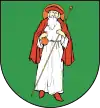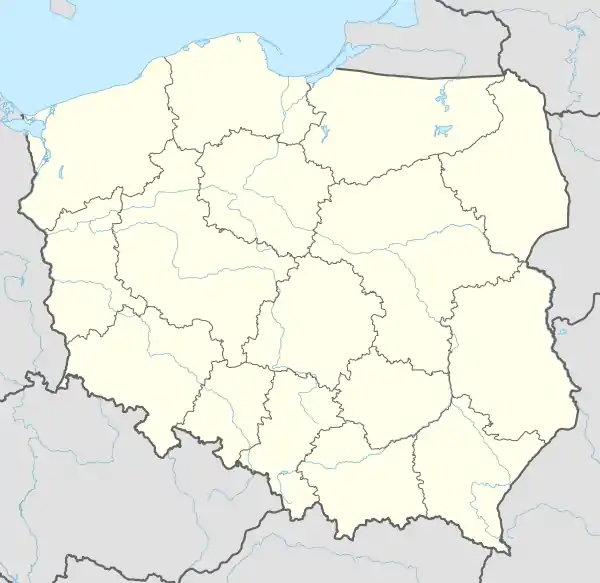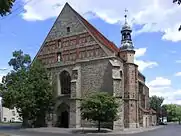Sobótka
Sobótka (pronounced So-boo-tka [sɔˈbutka], German: Zobten am Berge) is a town in Wrocław County, Lower Silesian Voivodeship, in south-western Poland. It is the seat of the administrative district (gmina) called Gmina Sobótka. Sobótka is located about 30 km (19 mi) southwest of Wrocław on the northern slope of Mount Ślęża, part of the Central Sudetes mountain range. As of 2019, the town has a population of 6,981.
Sobótka | |
|---|---|
.jpg.webp) Sobótka-Górka Castle | |
 Coat of arms | |
 Sobótka | |
| Coordinates: 50°53′55″N 16°44′40″E | |
| Country | |
| Voivodeship | Lower Silesian |
| County | Wrocław |
| Gmina | Sobótka |
| First settled | 2nd century BC |
| City Rights | 1221/1399 |
| Government | |
| • Mayor | Mirosław Jarosz |
| Area | |
| • Total | 32.20 km2 (12.43 sq mi) |
| Highest elevation | 718 m (2,356 ft) |
| Lowest elevation | 150 m (490 ft) |
| Population (2019-06-30[1]) | |
| • Total | 6,981 |
| • Density | 220/km2 (560/sq mi) |
| Time zone | UTC+1 (CET) |
| • Summer (DST) | UTC+2 (CEST) |
| Postal code | 55-050 |
| Area code(s) | +48 71 |
| Vehicle registration | DWR |
| Website | http://www.sobotka.pl |
History

The area had been settled since prehistoric times, as evinced by numerous archaeological artefacts, and in the 2nd century BC Mount Ślęża was the site of a sanctuary of the Celtic Boii, marking a northern outpost of their settlement area.
In 1128, the Polish voivode Piotr Włostowic established an Augustinian monastery on Mount Ślęża which was later moved to Wrocław, while the area remained a property of the Augustinian order. The settlement was first mentioned in an 1148 bull issued by Pope Eugene III as Sabath, from Latin: sabbatum, Polish: Sobota, "Saturday", referring to a weekly market. The market rights were confirmed by the Silesian duke Bolesław I the Tall in 1193. His son Duke Henry I the Bearded granted it town privileges rights according to Magdeburg Law in 1221. The location of the city is on the ancient Amber Road and its first role was trade. After the Polish King Casimir III the Great had renounced Silesia, Sobótka in 1353, due to marriage of the Czech princess, became the Bohemian kings territory. King Wenceslaus explicitly acknowledged the city rights in 1399. The town was again purchased by the Augustinians in 1494.
As part of the Habsburg monarchy the town was devastated by the Thirty Years' War. With most of Silesia it was annexed by the Kingdom of Prussia in 1742. King Frederick William III finally secularized the Augustinian territory in 1810. From 1871 to 1945 it was part of Germany.
After the defeat of Nazi Germany in World War II the town became part of Poland again. The Treaty of Zgorzelec established Sobótka inside Polish territory, as Soviet pressure on East Germany had essentially changed Poland and Germany's borders to the Soviet Union's benefit.
On December 31, 1959 the village of Strzeblów was included within the town limits.
Sights
The main attraction of the area is the Mount Ślęża, one of the 28 peaks of the Crown of Polish Mountains. The name of the region Silesia comes from the name of that mountain. Now it is under reservation as ”Góra Ślęża landscape and geological reservation park”. With its 718 m.s.l. is the highest peak of the Sudetes Foreland. Its specific microclimate allows develop of the large species of Fauna and Flora. In ancient time (bronze) it was the Pagan Solar Cult center. The Christianization of the territory begins in the 10th century. The old Tourist House of PTTK and the 19th-century Church of the Visitation of Mary are located at the sight.
There are many touristic paths as well for the pedestrians and for the cyclists. In the oldest house in center of Sobótka there is an archeological museum of Mr. Stanisław Dunajewski showing the large exposition of what was found nearby Ślęża Mountain. Historic sights include the Sobótka-Górka castle, the churches of Saint Anne (XIII/XIV) and Saint Jacob (1738) and the town hall.
Historical names of the city
- 1148 – "Sabath"
- 1193 – "Sobath"
- 1200 – "Sobat"
- 1256 – "Czobotha"
- 1329 – "Zobota"
- 1336 – "Zobotka"
- 1343 - "Czoboten"
- 1399 - "Czobothen"
- 1404 - "Czobotaw"
- 1561 - "Zobten"
- 1938 - "Zobten am Berge"
- 1945 - "Sobótka"
Notable people
- Dieter Grahn (born 1944), German rower
- Tadeusz Dolny (born 1958), retired Polish football player
Twin towns – sister cities
References
- "Population. Size and structure and vital statistics in Poland by territorial divison in 2019. As of 30th June". stat.gov.pl. Statistics Poland. 2019-10-15. Retrieved 2020-02-14.
| Wikimedia Commons has media related to Sobótka. |


.jpg.webp)
